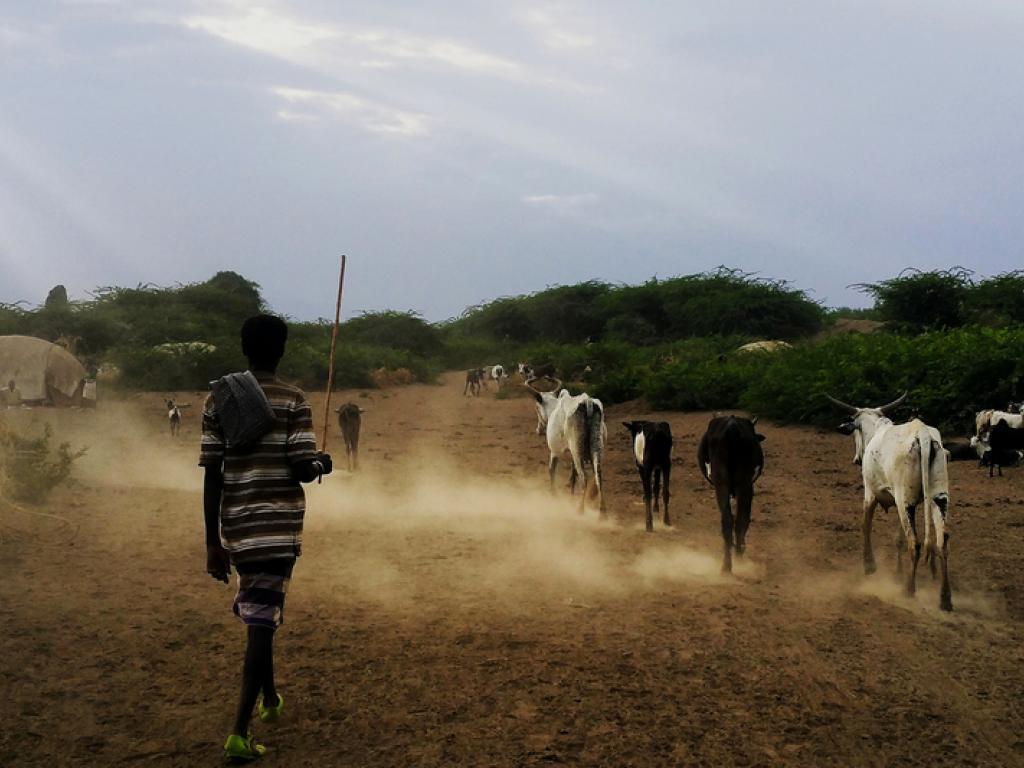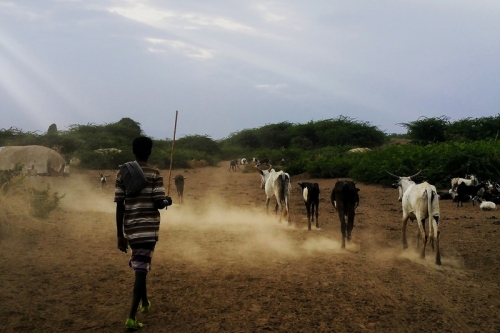Climate change adaptation: people first


A pastoralist herding cows and goats in the semi-arid Awash River Basin in Ethiopia, one of ASSAR's research areas in East Africa.
An international, transdisciplinary research project on climate change adaptation in semi-arid regions, co-led by the University of Cape Town (UCT), has released its findings following five years of research collaboration across six countries in Africa and three states in India.
Adaptation at Scale in Semi-Arid Regions (ASSAR) was a research consortium of 17 partners from 11 countries that studied how climate change affects the well-being and livelihoods of communities living in the semi-arid regions of Botswana, Namibia, Ghana, Mali, Kenya, Ethiopia and India. It also looked at the barriers and enablers to effective, sustained and widespread adaptation from now until the 2030s.
“The semi-arid regions of Africa and Asia – which are home to hundreds of millions of people – are particularly vulnerable to climate-related risks,” says Professor Mark New, director of UCT’s African Climate and Development Initiative (ACDI) and ASSAR’s principal investigator.
“These climate-change hotspots are dynamic systems that already experience harsh climates, adverse environmental change and a competition for natural resources. Even a 1.5 °C increase in global temperature will result in warming in semi-arid regions that is greater than the global average.
“This will have severe impacts on local agriculture, health and other vulnerable sectors.”
“The semi-arid regions of Africa and Asia – which are home to hundreds of millions of people – are particularly vulnerable to climate-related risks.”
ASSAR’s work was driven by the urgent need to accelerate adaptation in semi-arid regions to safeguard the livelihoods and well-being of the vulnerable communities who live there.
“From 2014 to 2018, we worked with a range of stakeholders to explore the dynamics and drivers of vulnerability across 12 themes, including governance, social differentiation, ecosystem services, gender and knowledge systems,” says ASSAR’s project manager, Lucia Scodanibbio.
“At the same time, we worked to strengthen the capacities of governments, local organisations and people to adapt in ways that minimise vulnerability, strengthen agency and promote long-term well-being. This ensured that ASSAR’s impact would live on after the project was completed.”
ASSAR was a partnership between five lead managing institutions and organisations – UCT, the University of East Anglia (United Kingdom), START (United States of America), Oxfam GB (United Kingdom) and the Indian Institute for Human Settlements (India) – and 12 partner organisations. It was one of four hotspot research projects of the Collaborative Adaptation Research Initiative in Africa and Asia programme, which was funded by Canada’s International Development Research Centre and the United Kingdom’s Department for International Development.
Living on the frontline
ASSAR sought to shift the focus of adaptation. The researchers wanted to move away from a narrative centred on infrastructural and technical solutions – such as providing irrigation, installing borewells or exploring new drought-tolerant crop varieties – to one centred on the people living on the frontline of climate change. ASSAR did this using a research-into-use approach that addressed some of the barriers posed by power structures, social norms that make some people – such as women and children – more vulnerable, and governance disconnects to effective adaptation.
“Technical solutions are critical, but they need to be paired with effective participation from local actors who themselves need access to financial, technical, institutional and political support,” says Scodanibbio.
She explains that communities living in semi-arid regions are especially vulnerable in the face of both climate and non-climatic challenges – such as rapid population growth, high rates of poverty and inequality – and have little opportunity to engage in decision-making processes that could affect their ability to adapt.
“Technical solutions are critical, but they need to be paired with effective participation from local actors who themselves need access to financial, technical, institutional and political support.”
“While many people in these regions are remarkably resilient, the rate at which we expect these multiple pressures to escalate in coming decades means that their traditional coping strategies will simply not be enough.”
1.5 °C warmer: not the same everywhere
One of ASSAR’s major contributions to science and policy was through the way some of its key team members, working as authors, helped shape the Intergovernmental Panel on Climate Change’s (IPCC) Special Reports on 1.5 °C and Land. And now, even though ASSAR is complete, its legacy continues, with many team members also contributing to the Sixth Assessment Report, due to be finalised in 2021.
“The Paris Agreement set international targets to keep global warming to well below 2 °C, with an ambition of limiting warming to 1.5 °C,” says New. “But with the current emissions trajectory suggesting the world will exceed the 1.5 °C target sometime in the 2020s, countries need to implement and enhance their commitments, and prepare for the local impacts of global warming.”
ASSAR’s research helped quantify the impacts of each increment of change in global temperature and illustrated the growing risks to the livelihoods and well-being of people in semi-arid areas.
“For example, we found that semi-arid zones in Botswana, Namibia and Mali will experience higher levels of warming than the global average,” continues New. “Temperatures in the semi-arid zones of Kenya, Ethiopia, Ghana and India will also rise above the global average, but will not warm as quickly as those in southern Africa and Mali.”
According to New, global warming of 1.5 °C and above will have profound impacts on the dominant sources of livelihoods in semi-arid regions, such as rain-fed agriculture and pastoralism. ASSAR’s findings show that agricultural and livestock productivity could decline, and health and disease burdens of semi-arid communities could increase.
ASSAR recommends that policymakers in semi-arid regions prepare for growing climate risks by
- building robust drought management strategies
- coordinating water governance with inclusive decision-making
- improving flood-risk management strategies, and
- planning policy for the transformation of livelihoods and migration of people out of these areas.
“For effective policy-making, it is crucial to understand the cultural, social and ecological context of each community, the factors that influence people’s vulnerability and ability to respond to risks, and their well-being,” concludes Scodanibbio. “We need to work more closely with stakeholders to design and develop adaptation interventions, because in the end, adaptation is about people.”
Download a summary of ASSAR’s findings.
Read the country-level reports for Botswana, Namibia, Ghana, Mali, Kenya, Ethiopia and India.
Story: Birgit Ottermann
Photo: Jennifer Leavy